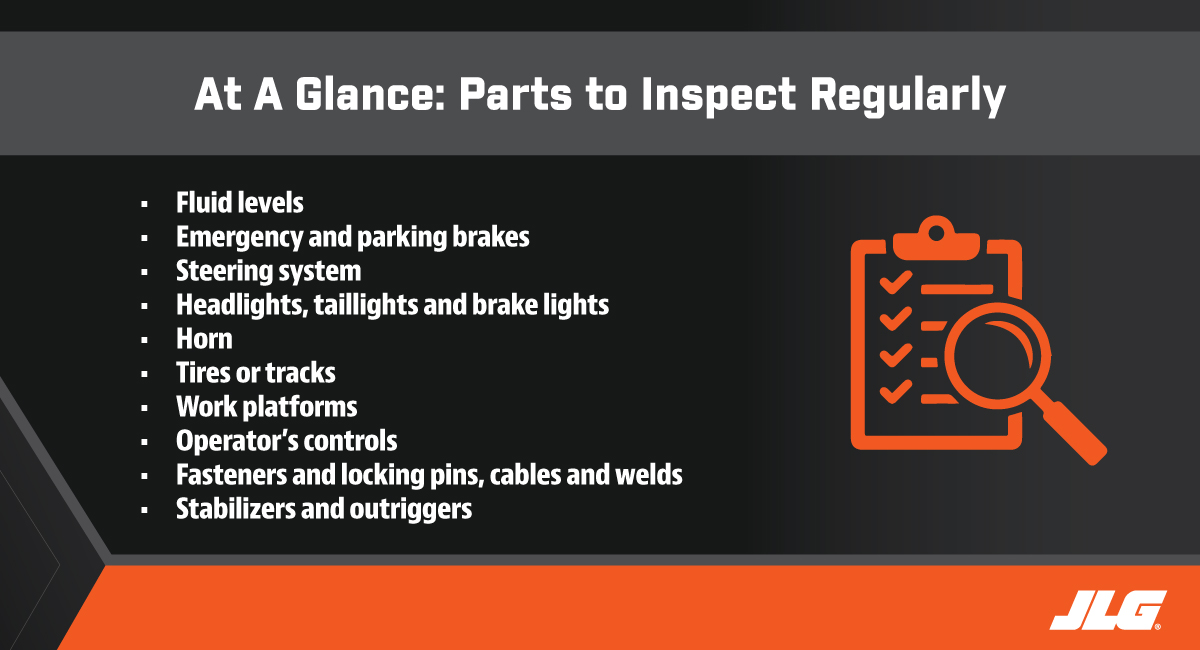![]() Wade Jones
Wade Jones
Sr. Director of Operations
____
JLG Industries
To keep MEWPs (mobile elevating work platforms) and telehandlers in good working order, the parts on these machines need to be thoroughly inspected and serviced regularly to help prevent operator injuries, major repairs and unplanned downtime.
While each component on a machine should be inspected following the OEM’s recommended maintenance schedule, some parts require more frequent attention. Get to know which wear parts are important to inspect — and what signs suggest it’s time to replace them.

Parts to check regularly
Any part that affects the safety or productivity of a machine should be checked often. Using a combination of hands-on and data inspections, be sure you regularly check these wear parts to ensure operator safety and equipment efficiency.
Some of the easiest components to check are also ones that can have the most severe consequences if they have issues. For example, a walkaround of a telehandler before use should include the machine’s tires and fluid levels (hydraulic, oil, DEF, fuel, etc.), as well as steering and brake (emergency and parking) systems, headlights, taillights, brake lights, horn and windshield wipers. If any of those aren’t functioning properly, it could cause injuries to your crew or damage to other equipment.
On a MEWP, it is important to check the work platform carefully, including the operator’s controls (ex. switches and buttons), guard rails, fasteners, locking pins, harnesses, welds, cables, stabilizers and outriggers to ensure they aren’t damaged, loose or missing parts. Issues with any of the parts could cause the operator to fall or parts to fall off from an extended height, which could seriously injure someone below.
Tires and tracks also play an important role in keeping a MEWP or telehandler reliable on the job site. These can be damaged by surface materials, incorrect installation, heat and other job site conditions.
Additional inspection items can be found in a machine’s Operation and Safety Manual, which may be stored in the manual storage box or the operator’s cab. Manuals for JLG® MEWPs and telehandlers can also be accessed here or in the technical publications section on Online Express, the company’s online parts purchasing system and resource center.
In addition to planned inspections for these worn parts, it’s also important to ask for operator feedback about how the machine is functioning. They might notice a slight change in the equipment — whether that’s a rattling or reduction in efficiency — that will help you identify potential issues before you visually notice them.
When is it time to replace it?
While each type of part will present its own signs that it’s worn, here are some general guidelines that it’s time to replace.
If any of the lights or the horn on a piece of equipment fails to work, it’s time to replace them — and remove the machine from service until they are fixed. Always make sure that all of the machine’s operation switches, buttons and controls work properly.
Watch for tires that have bulges or broken belts, damaged or loose lug nuts, chunking treads, low pressure, punctures (cuts, rips or tears), exposed sidewalls or the fill becomes compromised. For additional guidance on tire and rim requirements for JLG MEWPs, click here.
Signs that tracks need to be replaced include finding visible steel cording, cracks, worn sprockets, loss of tension, missing or loose lug nuts or if they become nearly flat. Keeping tracks free of debris can help prevent damage and extend their life.
Work platforms and their components that have dents, damage, excessive rust or cracks to the welds need to be addressed before operation. Ensure nothing is missing or damaged before use, as well.
If any of these wear parts appear to be worn — but aren’t to the point of needing to be replaced yet — check them daily. Even if they haven’t had issues yet, they may begin affecting the machine’s level of efficiency and productivity and need to be replaced. Always consult the OEM-approved Operation and Safety Manual and Parts Manual for the machine for additional guidance on replacing wear parts.
Stick to the inspection checklist
Regularly inspecting wear parts could be the difference between a routine replacement and costly repairs. How and where the machine is used also contributes to its ongoing productivity and efficiency. It’s important for crews to also check for environmental job site hazards like uneven terrain, severe weather, debris and other obstructions in their daily workplace inspections.
Incorporating these inspections into the preventive maintenance schedule will ensure that they are conducted before the components wear out. Following the manufacturer’s suggested schedules, listening to operator input and tracking operational data can flag any potential issues.
JLG provides equipment users with on-demand access to the most current technical support, parts, training and new product/service information available, helping to make sure its MEWPs and telehandlers continue operating at peak performance. For more resources on parts and services from JLG, click here.
Do you want to stay up to date with industry news and issues similar to this? Make sure you subscribe below to receive monthly updates from Direct Access with newly posted content so you never miss important information.